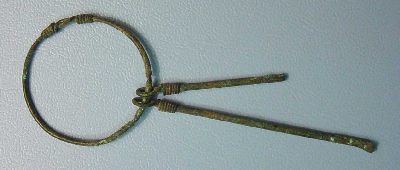 |
| Roman toothpick from Trier |
The Romans often suffered from toothache. So they came up with strange ideas: frogs were boiled in vinegar, and the broth was used to rinse one's mouth. There was even the superstition that the urine of little boys would be good for the teeth.
The Latin word "dentiscalpium" proves that the ancient Romans knew a device with which to brush their teeth. In his book "The Banquet", part of a 16-volume opus, Petronius ARBITER, a contemporary of Nero's, describes how the host brushed his teeth with a "spica argentea", a silver pest, before eating. However, this seems to be the only Roman passage in which a metal object was used as a toothpick. In general, the Romans used natural products for oral care mastic, quills): M. Valerius MARTIALIS, born from 40-103 AD. lived, thought in his works of a toothpick not less than 4 times. Thus, in the 14th book of his "Epigrammaton libri" he left us a kind of vocabulary in which, under the rubric "Dentiscalpium", he knows that in the absence of a hardwood stick one may also use a feather to clean the teeth:
Lentiscus melius: sed si tibi frondea cuspis
Defuerit, debtes pinna levare potest.
Presumably, the metal toothpick was combined with other devices of body cleansing (tongue scraper, ear spoon or head scraper) to a bunch. The instrumentation made of a copper alloy presented here was found in 1999 on the occasion of a private excavation (Ursulinenstrasse) in Trier. The ring has a diameter of 36 mm, the tooth (?) Scraper has a length of 67 mm, the broken peg (?) Resp. the remainder of an ear spoon (?) is only 40 mm long. Even if the cutlery was not a toothpick at first, it became so when the spoon resp. the other part broke: "recycling" in the old days.
At the beginning of modern times, the pommel became an indispensable accessory: in the estate of the merchant Lucas Reiff, who died in Luxembourg in 1768, we find "Un cure-dent, se trouve d'or, pèse 3 quintels à 7 patacons le lot" (N. van Werveke, Cultural History of the Lux. Land III, Luxembourg 1926 p. 72).
Literatur:
Hans Sachs, Der Zahnstocher und seine Geschichte. Eine kulturgeschichtlich-kunstgewerbliche Studie (Reihe: Kulturgeschichte der Zahnheilkunde in Einzeldarstellungen, Band 1, 62 S Orig.Leinen kl4°; mit 87 Abbildungen und 1 Tafel, Berlin 1913
Hirschfelder, Gunther, Europäische Esskultur. Geschichte der Ernährung von der Steinzeit bis Heute. 2001, 327 S. ISBN: 3593368153
|




